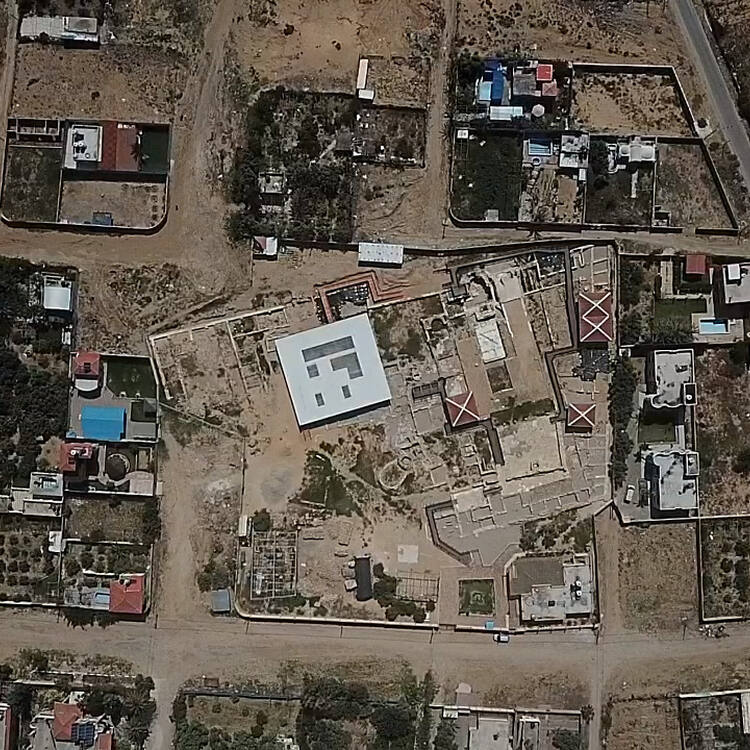Saint Hilarion Monastery/ Tell Umm Amer
Saint Hilarion Monastery/ Tell Umm Amer
Situated on the coastal dunes in Nuseirat Municipality, the ruins of Saint Hilarion Monastery/ Tell Umm Amer represent one of the earliest monastic sites in the Middle East, dating back to the 4th century. Founded by Saint Hilarion, the monastery began with solitary hermits and evolved into a coenobitic community. It was the first monastic community in the Holy Land, laying the groundwork for the spread of monastic practices in the region. The monastery occupied a strategic position at the crossroads of major trade and communication routes between Asia and Africa. This prime location facilitated its role as a hub of religious, cultural, and economic interchange, exemplifying the flourishing of monastic desert centres during the Byzantine period.
Description is available under license CC-BY-SA IGO 3.0
Monastère de Saint Hilarion/ Tell Umm Amer
Situés sur les dunes côtières de la municipalité de Nousseirat, les vestiges du monastère de Saint Hilarion/Tell Umm Amer, représentent l’un sites monastiques les plus anciens du Moyen-Orient, datant du IVe siècle. Le monastère, fondé par Saint Hilarion, accueillit des ermites avant de devenir le lieu de vie d’une communauté cénobitique. Première communauté monastique en terre sainte, elle permit la diffusion des pratiques monastiques dans la région. Le monastère occupait une position stratégique, au carrefour des principales routes de commerce et d’échanges entre l’Asie et l’Afrique. Cette localisation favorable en fit un centre d’échanges religieux, culturels et économiques, illustrant la prospérité des centres monastiques désertiques de la période byzantine.
Description is available under license CC-BY-SA IGO 3.0
دير القديس هيلاريون / تل أم عامر
تقع أطلال دير القديس هيلاريون / تل أم عامر على التلال الساحلية في بلدية النصيرات، وهو أحد الأديار الأولى في الشرق الأوسط، إذ يعود تاريخه إلى القرن الرابع الميلادي. وكان قد أسسه القديس هيلاريون، حيث بدأ الدير كصومعة للتنسك المنفرد ثم تطور ليصبح مجتمعاً رهبانياً. وكان هذا الدير أول مجتمع رهباني في الأرض المقدسة حيث مهَّد السبيل أمام انتشار الممارسات الرهبانية في المنطقة. ويقع الدير في نقطة استراتيجية على تقاطع طرق رئيسية للتجارة والاتصال بين آسيا وأفريقيا. وقد يسَّر هذا الموقع المتميز الدور الذي أداه الدير كمركز للتبادل الديني والثقافي والاقتصادي، مقدماً بذلك مثالاً على الأديرة الصحراوية التي انتشرت في العصر البيزنطي.
source: UNESCO/CPE
Description is available under license CC-BY-SA IGO 3.0
圣希拉里翁修道院 / 特尔乌姆阿迈尔
圣希拉里翁修道院 / 特尔乌姆阿迈尔(Tell Umm Amer)遗址位于努赛赖特市的海岸沙丘地带,是中东最古老的修道院之一,其历史可追溯至公元4世纪。它由圣希拉里翁创建,从最初隐居修士的容身之所逐渐发展为集体修道社区,成为“圣地”首个修道院社区,为修道院习俗在当地的传播奠定基础。修道院坐落在亚非大陆多条贸易及交通要道的交汇之处,优越的地理位置使其成为宗教、文化、经济交流的枢纽,以及拜占庭时期沙漠修道中心蓬勃发展的范例。
source: UNESCO/CPE
Description is available under license CC-BY-SA IGO 3.0
Монастырь Святого Иллариона/ Телл Умм Амер
Руины монастыря Святого Иллариона/Телл Умм Амер расположены на прибрежных дюнах в городе Нусейрат. Это одно из самых ранних монашеских поселений на Ближнем Востоке, основанное в IV веке. Монастырь был основан Святым Илларионом. Изначально в нем жили отшельники-одиночки, а затем он превратился в киновию.
Монастырь стал первой монашеской общиной на Святой Земле и положил начало распространению практик монашества в этом регионе. Он занимал стратегическое положение на перекрестке основных торговых и коммуникационных путей между Азией и Африкой. Благодаря такому удачному расположению монастырь стал центром религиозного, культурного и экономического обмена, а также свидетельством расцвета центров монашества в пустыне в византийский период.
source: UNESCO/CPE
Description is available under license CC-BY-SA IGO 3.0
Monasterio de San Hilarión / Tell Umm Amer
Las ruinas del Monasterio de San Hilarión / Tell Umm Amer, situadas en las dunas costeras del Municipio de Nuseirat, representan uno de los primeros sitios monásticos en el Medio Oriente, que data del siglo IV. Fundado por San Hilarión, el monasterio comenzó con ermitaños solitarios y evolucionó hacia una comunidad cenobítica. Fue la primera comunidad monástica en Tierra Santa y sentó las bases para la expansión de las prácticas monásticas en la región. Su ubicación estratégica, en la encrucijada de importantes rutas comerciales y de comunicación entre Asia y África, facilitó su papel como centro de intercambio religioso, cultural y económico. Este enclave ejemplifica el florecimiento de los centros monásticos en el desierto durante el periodo bizantino.
source: UNESCO/CPE
Description is available under license CC-BY-SA IGO 3.0

